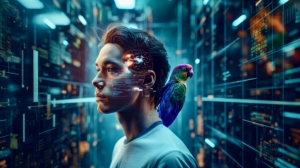Artificial Intelligence or Stochastic Parrot? A Case for ‘Artificial Intuition’

Introduction
The term “Artificial Intelligence” has become a staple in our modern lexicon, but does it accurately reflect what these systems truly do? Notable intellectuals like Noam Chomsky have criticized the use of “intelligence” in describing AI, arguing that it creates misconceptions about the nature and capabilities of these systems.
Critique of “Artificial Intelligence”
In a New York Times article from March 8, 2023, Chomsky, along with Dr. Ian Roberts and Dr. Jeffrey Watumull, made a compelling case against the current nomenclature of AI. They argue that:
“The human mind is not, like ChatGPT and its ilk, a lumbering statistical engine for pattern matching, gorging on hundreds of terabytes of data and extrapolating the most likely conversational response or most probable answer to a scientific question. On the contrary, the human mind is a surprisingly efficient and even elegant system that operates with small amounts of information; it seeks not to infer brute correlations among data points but to create explanations…”
Chomsky’s critique highlights a fundamental difference between human cognition and what AI systems do. While AI excels at processing vast amounts of data and identifying patterns, it lacks the ability to create explanations or understand context in the nuanced way humans do.
The Argument for “Plagiarism Software”
Chomsky and his colleagues further argue:
“… Let’s stop calling it ‘Artificial Intelligence’ then and call it for what it is and makes ‘plagiarism software’ because ‘It doesn’t create anything, but copies existing works, of existing artists, modifying them enough to escape copyright laws…'”
This provocative statement underscores the concern that AI systems, in their current form, do not possess true creativity or understanding. Instead, they remix and reconfigure existing data to generate outputs that may appear novel but are fundamentally derivative.
Introducing the “Stochastic Parrot”
Another term that has been used to describe AI systems like ChatGPT is “stochastic parrot.” This term, coined by Emily M. Bender and her colleagues, emphasizes the idea that AI systems are essentially sophisticated parrots, repeating and reassembling fragments of language they have been trained on without genuine understanding. A “stochastic parrot” operates by statistically predicting the next word in a sequence based on its training data, much like a parrot mimicking human speech without grasping its meaning.
Neuroscience: The Inspiration Behind AI
The origins of AI are deeply rooted in the study of the human brain. Neuroscience has provided crucial insights into how our brains process information, learn, and make decisions. These insights have inspired the development of AI, particularly in the design of neural networks that mimic the structure and function of the human brain. However, while AI can replicate certain patterns of human thought, it lacks the intuitive and creative abilities that characterize true human intelligence.
Why “Artificial Intuition” Makes Sense
1. Pattern Recognition Over Understanding
AI systems like ChatGPT are adept at recognizing patterns in data and generating responses based on these patterns. This process is more akin to intuition, which operates on a subconscious level in humans, rather than intelligence, which involves conscious thought and reasoning.
2. Response Generation Without Comprehension
AI can produce outputs that seem intelligent, but it lacks genuine comprehension. By reframing AI as “Artificial Intuition,” we acknowledge its ability to generate useful responses without attributing to it a level of cognitive understanding it does not possess.
3. Focus on Practical Use
The term “Artificial Intuition” could help shift the focus from speculative fears about AI surpassing human intelligence to a more practical understanding of its strengths and limitations. This can foster more realistic expectations and guide responsible development and deployment of AI technologies.
Conclusion
In conclusion, while “Artificial Intelligence” has become deeply ingrained in our discourse, it’s important to critically assess whether it accurately represents the capabilities of these systems. By considering alternatives like “Artificial Intuition” or recognizing the concept of a “stochastic parrot,” we can better align our terminology with the true nature of AI and its role in our world.
[By Mark Dillerop (with the assistance of ChatGPT and Midjourney)]About the author : Mark Dillerop
Recent Posts
🤖💬🧠 “You can always ask my agent.”
A phrase that might soon become second nature — especially[...]
Book Review: HBR Guide to Generative AI for Managers
HBR Guide to Generative AI for Managers ($21.95)🌟 Rating:[...]
Innovation vs. Regulation
Will AI Be Stifled or Supercharged? As AI rapidly advances,[...]
AI and Jobs
Will Artificial Intelligence Destroy or Empower the Workforce? One of[...]
AI as a Weapon in the Geopolitical Arena
How the U.S. Aims to Maintain Technological Dominance Artificial Intelligence[...]
Short Summary of the Research on Griefbots, Deadbots, postmortem avatars and the Digital Afterlife (published 9 may 2024)
The research by Tomasz Hollanek and Katarzyna Nowaczyk-Basińska was published[...]
